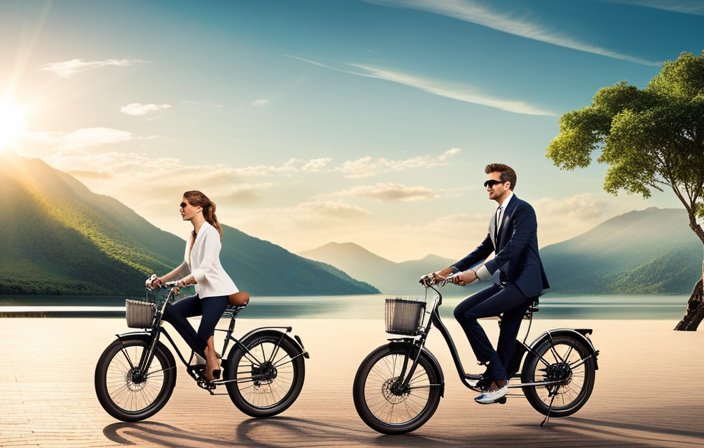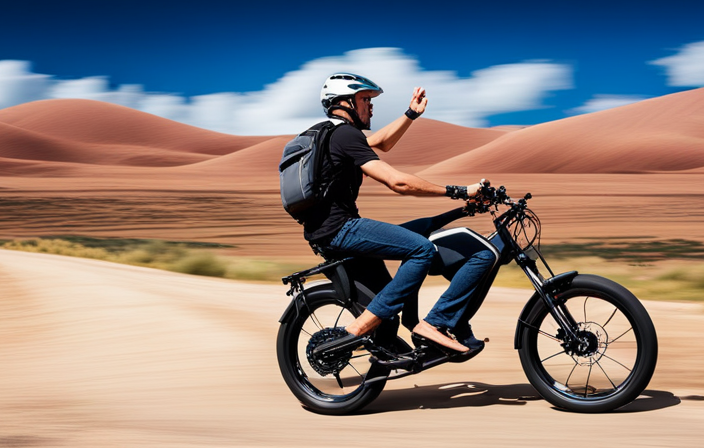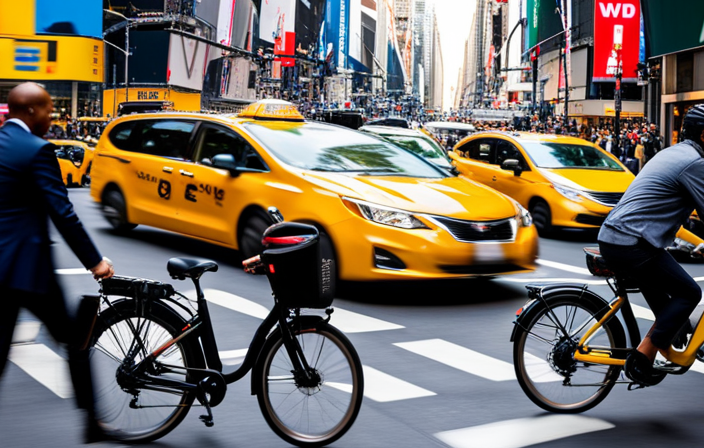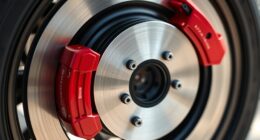Are you prepared to begin an exhilarating adventure? Imagine yourself gliding down the streets on your electric bike, feeling the breeze on your face.
But hold on, how long will that battery charge last? Fear not, as we delve into the intricate factors that determine the lifespan of an electric bike battery charge.
From battery capacity and riding conditions to maintenance and care, we’ll equip you with the knowledge to maximize your adventure.
So, buckle up and prepare to unravel the secrets of electric bike battery longevity.
Key Takeaways
- Proper battery charging techniques, such as avoiding overcharging and charging at regular intervals, can help increase the overall battery life.
- Using the provided charger and avoiding fast charging methods can prevent battery degradation.
- Proper battery storage, including avoiding extreme temperatures and storing in a cool and dry place, can help prevent capacity decrease over time.
- Factors such as age, usage, and the number of charge cycles can impact battery life, so striking a balance between regular use and minimizing excessive wear is important.
Battery Capacity and Type
How long does an electric bike battery charge last will depend on the capacity and type of battery you’re using. Battery life is a crucial factor to consider when purchasing an electric bike. The capacity of the battery, measured in watt-hours (Wh), determines how much energy it can store. Generally, higher-capacity batteries will provide longer riding time.
Additionally, the type of battery also plays a role in determining its lifespan. Lithium-ion batteries are commonly used in electric bikes due to their high energy density and long cycle life.
Charging time is another important factor to consider. Most electric bike batteries can be fully charged within 3-6 hours, depending on the charger and battery capacity. It is essential to choose a battery with sufficient capacity and consider the charging time to ensure optimal performance. Over time, the electric bike battery lifespan can be affected by frequent charging and discharging cycles. To extend its longevity, it is advisable to follow the manufacturer’s guidelines on charging habits and avoid overcharging. Proper maintenance and storage conditions also play a crucial role in preserving battery efficiency and ensuring reliable performance.
Now, let’s delve into how riding conditions and terrain affect the battery’s lifespan.
Riding Conditions and Terrain
When riding in different conditions and terrains, you’ll find that the duration of your e-bike battery’s charge can vary. Elevation changes and road surface conditions play a significant role in determining how long your battery will last. When traveling uphill, the motor has to work harder, which drains the battery faster. On the other hand, when riding downhill, you can conserve the battery since the motor doesn’t need to provide as much assistance. Additionally, rough road surfaces can increase resistance and require more power from the battery. To illustrate this, consider the following table:
| Riding Conditions | Battery Duration |
|---|---|
| Uphill | Decreased |
| Downhill | Conserved |
| Rough surfaces | Decreased |
Understanding how these factors affect your battery charge can help you plan your rides more efficiently. Moving forward, let’s delve into the next section about pedal assist levels.
Pedal Assist Levels
Pedal assist levels can greatly influence the performance of your e-bike. This feature allows you to choose the level of assistance provided by the electric motor while you pedal. By adjusting the pedal assist level, you can customize the amount of power and speed you want from your e-bike.
When it comes to e-bike performance, the pedal assist levels play a crucial role. Higher assist levels provide more power and acceleration, allowing you to conquer steep hills and challenging terrains with ease. On the other hand, lower assist levels conserve energy and extend the battery life, making your rides last longer.
One of the key factors affected by pedal assist levels is the energy efficiency of your e-bike. By selecting the appropriate assist level based on the terrain and your desired speed, you can optimize the battery usage and maximize the overall efficiency of your ride.
Understanding the impact of pedal assist levels on e-bike performance and energy efficiency is essential for getting the most out of your electric bike. Now let’s delve into how rider weight and riding style can also influence your e-bike’s performance.
Rider Weight and Riding Style
Rider weight and riding style can significantly impact the performance of your e-bike. The weight distribution of the rider can affect how efficiently the battery is used, ultimately affecting battery charging time.
When the weight is evenly distributed, the e-bike can maintain a more balanced and stable ride, allowing for better battery performance. On the other hand, if the weight is concentrated in one area, such as the front or back, it can put strain on the battery and lead to quicker depletion and longer charging times.
Additionally, the riding style of the rider can also influence battery life. Aggressive riding, such as constant high speeds and sudden acceleration, can drain the battery faster compared to a more relaxed and steady riding style.
Understanding how rider weight and riding style impact the battery can help you optimize your e-bike’s performance. Moving on to the next section about speed and acceleration, let’s explore how these factors can further affect your e-bike experience.
Speed and Acceleration
Speed and acceleration can greatly impact the overall performance of your e-bike. The battery efficiency is directly affected by these factors, as the more power is required to achieve higher speeds and quicker acceleration.
Here are three key points to understand the impact of speed and acceleration on your e-bike’s battery efficiency and overall performance:
-
Increased Speed: Riding at higher speeds will drain your battery more quickly, as it requires more energy to maintain the increased velocity.
-
Quick Acceleration: Rapid acceleration also puts a strain on the battery, as it demands a sudden burst of power to propel the bike forward.
-
Range Reduction: Both speed and acceleration can significantly reduce the range of your e-bike, limiting the distance you can travel on a single charge.
Considering these factors, it is important to strike a balance between speed, acceleration, and battery efficiency. Speaking of which, weather conditions can also play a role in determining the performance of your e-bike.
Weather Conditions
When it comes to riding an e-bike, you’ll want to consider how weather conditions can affect your overall performance.
Weather conditions play a significant role in determining the charging time and battery lifespan of your electric bike. Cold temperatures can decrease the efficiency of the battery, resulting in longer charging times and reduced range. On the other hand, extreme heat can also impact the battery’s performance and lead to a shorter lifespan.
It’s important to store your e-bike in a temperature-controlled environment to maximize its battery life. Additionally, riding in heavy rain or snow can increase the risk of water damage to the battery and other electronic components. Therefore, it is crucial to be mindful of the weather conditions when using and charging your electric bike to ensure optimal performance and longevity.
Speaking of battery management systems, let’s discuss how they contribute to maximizing battery efficiency.
Battery Management Systems
Now that you understand how weather conditions can affect the performance of an electric bike battery, let’s dive into the topic of battery management systems. These systems play a crucial role in the battery charging process and optimizing battery efficiency.
A battery management system (BMS) is a sophisticated electronic system that manages the charging and discharging of the battery. It monitors various parameters such as voltage, current, temperature, and state of charge to ensure the battery operates within safe limits. The BMS also helps prevent overcharging and undercharging, which can negatively impact the battery’s lifespan.
One of the key functions of a BMS is to balance the individual cells within the battery pack. This ensures that each cell is charged and discharged evenly, maximizing the overall performance and longevity of the battery.
By implementing a well-designed BMS, electric bike manufacturers can not only extend the battery life but also improve the overall riding experience. Now, let’s move on to the next section to discuss maintenance and care of electric bike batteries.
Maintenance and Care
Taking proper care of your electric bicycle’s battery is essential for maintaining its performance and extending its lifespan.
To ensure that your battery charges last as long as possible, it is important to follow proper battery charging techniques. Avoid overcharging your battery, as this can lead to decreased overall battery life. It is recommended to charge your battery at regular intervals, rather than letting it fully discharge before charging again.
Additionally, it is important to store your battery properly, avoiding extreme temperatures and keeping it in a dry environment. Common battery issues that can arise include a decrease in overall capacity over time and a decrease in performance in cold weather.
By following these maintenance and care tips, you can maximize the lifespan of your battery and ensure optimal performance.
Moving on to the next section about the age and usage of the battery, it is important to consider how these factors can impact battery life.
Age and Usage of the Battery
To maximize the lifespan and performance of your electric bicycle’s battery, it’s important to consider how factors such as the age and usage of the battery can impact its overall longevity and effectiveness.
Battery charging techniques play a crucial role in maintaining the health of your battery. It is recommended to avoid overcharging or undercharging the battery, as this can lead to premature degradation. Additionally, charging the battery at moderate temperatures is essential for optimal performance.
Battery degradation factors, such as the number of charge cycles and the depth of discharge, should also be taken into account. The more frequently you charge and discharge your battery, the quicker it will degrade over time. It’s important to strike a balance between regular use and minimizing excessive wear on the battery.
Now, let’s move on to some tips for maximizing battery life.
Tips for Maximizing Battery Life
Make sure to follow these tips to get the most out of your electric bicycle’s battery.
Proper battery charging techniques are essential for maximizing its lifespan. First, always use the charger provided by the manufacturer to ensure compatibility and optimal performance. Avoid fast charging methods as they can degrade the battery over time.
Secondly, it is important to store the battery correctly when not in use. Keep it in a cool and dry place, away from extreme temperatures and direct sunlight.
Lastly, avoid fully draining the battery on a regular basis. Instead, aim to keep it between 20% and 80% charged, as this range is ideal for battery longevity.
By following these tips, you can extend the life of your electric bike’s battery and enjoy longer rides without worrying about running out of power.
Frequently Asked Questions
Are there any specific safety precautions I need to take when charging an electric bike battery?
To ensure safe charging and maximize the charging duration of your electric bike battery, follow these precautions: use a charger specifically designed for your battery, avoid overcharging, charge in a well-ventilated area, and regularly inspect the charging equipment for any damage.
Can I use any type of charger to charge my electric bike battery?
Using an incompatible charger for your electric bike battery is like trying to fit a square peg in a round hole. It can cause serious damage and even lead to battery failure. Stick to the recommended charger for safe and efficient charging.
How long does it take to fully charge an electric bike battery?
To fully charge an electric bike battery, it typically takes around 3-6 hours, depending on the charging speed and the battery’s capacity. Optimal charging methods include using the manufacturer’s recommended charger and avoiding overcharging or rapid charging for prolonged battery life.
Is it possible to overcharge an electric bike battery?
Overcharging an electric bike battery is a grave mistake! It can lead to disastrous consequences and significantly shorten the battery lifespan. So, be wise and avoid overcharging your precious battery!
Can I use my electric bike while the battery is charging?
Using an electric bike while the battery is charging can negatively impact the bike’s performance due to increased power demand. Frequent battery charging can reduce overall battery life and may lead to decreased efficiency and power output.
Conclusion
So, there you have it! Now you know all the factors that can influence how long an electric bike battery charge lasts.
From the battery capacity and type to the riding conditions and terrain, each element plays a crucial role in determining the battery life.
Additionally, factors like pedal assist levels, rider weight and riding style, speed and acceleration, and battery management systems all contribute to the overall battery performance.
By understanding these factors and following proper maintenance and care, you can maximize the lifespan of your electric bike battery.
So, get out there, ride smart, and enjoy the seamless and efficient ride that an electric bike offers!









